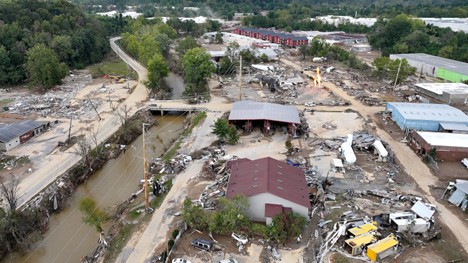The flooding that followed Hurricane Helene inundated Asheville, North Carolina, and surrounding communities with water dirtied by all manner of pollution.
(Photo: Mario Tama/Getty Images via Grist)
Western North Carolina will need an estimated $14.8 billion in housing assistance to recover from Hurricane Helene-related damage, state officials reported Wednesday.
The estimate by the North Carolina Office of State Budget and Management (OSBM) includes $12.2 billion to repair homes damaged mainly due to flooding and wind. The initial estimate is expected to change as the Federal Emergency Management Agency (FEMA) and other state and federal agencies continue to assesses storm damage, state officials said.
North Carolina state budget director Kristin Walker discusses the proposed Hurricane Helene relief spending package at a press conference on Oct. 23, 2024 in Raleigh. (Photo: Galen Bacharier/NC Newsline)
“About 92% of the household with damage do not have flood insurance,” State Budget Director Kristin Walker noted. “They will not be able to rely on private insurance to cover these losses, and we have a high percentage that was in this community region that was already overburdened by housing costs.”
Walker said the federal government is expected to put significant resources toward building and repairing homes through Community Development Block Grant funds, but warned that it could take up to two years to receive the money after the initial asks to Congress.
“So, this is an area where the governor [Roy Cooper] is recommending the state go ahead and put in $325 million into what would be a HUD [U.S. Department of Housing and Urban Development] – compliant homeowner recovery program to get the ball rolling and to get things started,” Walker said. “One of the lessons learned that we know is that waiting on the federal government and having a program that is entirely too federally fund-reliant means there are delays that are simply unacceptable to homeowners on the ground and those waiting to have their homes rebuilt.”
Walker said that the state can “ensure a smooth transition for homeowners who hopefully would not even know if they’re funding came either from a state dollar or a federal dollar” because we would go ahead and get this started now.
North Carolina Gov. Roy Cooper outlines the damages and relief money needed after Hurricane Helene at a press conference on Oct. 23, 2024 in Raleigh. (Photo: Galen Bacharier/NC Newsline)
Roughly, $8.7 billion in housing needs is expected to be covered by private and federal sources, resulting in an unmet housing impact of about $6 billion, officials said. An additional $3 million is needed for transitional shelter, officials said, $101 million for public assistance, $600 million in other assistance for households and housing and $1.8 billion for resilience efforts, they said.
Gov. Roy Cooper has recommended an initial $3.9 billion package to begin rebuilding critical infrastructure, homes, businesses, schools and farms damaged during the storm
The OSBM reported that approximately 126,000 homes are expected to be determined to have been damaged. Single-family homes, manufactured homes and duplexes account for the majority of residential structures damaged.
Displaced residents will need transitional and short-term housing, personal property replacement and other assistance, the report said. Public buildings, such as public housing authorities and other government programs related to housing, may have also suffered damages greater than local capacity can quickly cover, the OSBM report said.
Walker told reporters that 70% of homes in the region impacted by Hurricane Helene are on septic systems, which will present unique challenges as homeowner attempt to rebuild. A septic system is a wastewater treatment system that’s used in homes and businesses that aren’t connected to a public sewer system. They use a combination of natural and technological processes to treat wastewater from sinks, toilets, laundry, and showers.
“This is another area where we will rely heavily on the federal government assisting us,” Walker said.

